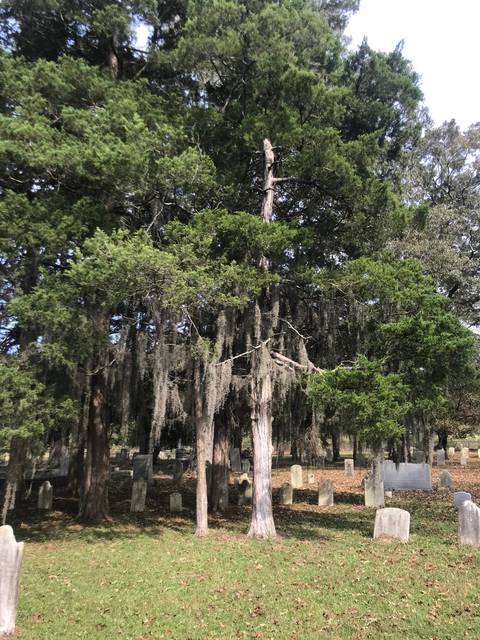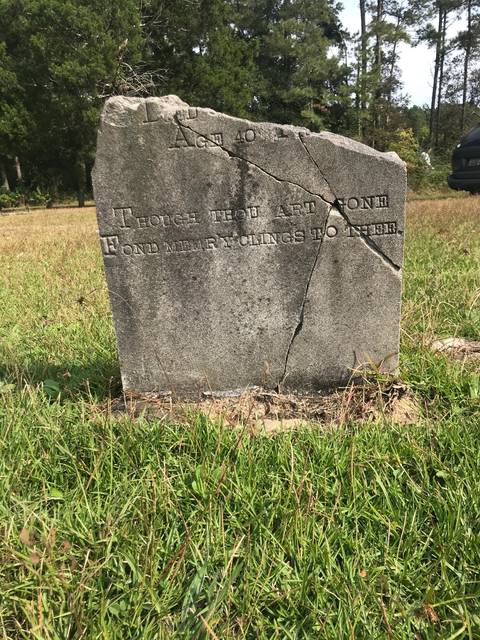Behind the chain-link fence, under the draping Spanish Moss and fallen tree limbs, lies an unremembered piece of Scotland County’s history — one that has been associated with spooky stories. Today, 288 stone gravemarkers sit on top of the nearly 8 acres of the graveyard in Stewartsville Cemetery.
Gravestones are cracked, weathered, and vandalized. The trees have shed most of their leaves, branches and large limbs lay under the trees from which they have fallen. In the daylight hours, the atmosphere is empty, still, and even serene.
For years, Stewartsville lay neglected. Its tombstones covered with vines, its graves overrun with debris, with only the handsome grove of oaks to mark its territory. Burials had become so frequent at one time that it was difficult to tell where many were buried. Shrubbery had almost taken over, and it was soon cut away. In 1913, Stewartsville was restored by those who wished to preserve its sacred associations.
Peaceful and eternal rest is what is expected when a loved one is buried. At Stewartsville Cemetery, this is not always the case.
Local legend holds that in 1785, a Revolutionary War soldier with the surname Stewart was the first to be buried in the cemetery. After Stewart was fatally wounded, the funeral party, which carried the solider, could not find sufficient burying ground. After searching for miles, the party stopped to rest at what is now known as Stewartsville Cemetery. While resting, it was suggested that this quiet, peaceful place would be ideal as a final resting ground for Stewart. The party agreed, and the grave was dug and marked with a pine plank.
Stewartsville Cemetery did not introduce stone gravemarkers until the late 1800s. Gravemarkers were made of cedar, cypress or longleaf heart pine – all durable woods. According to Beacham McDougald, a local historian, a fire burned all of the wooden markers, leaving unidentifiable graves.
Many of those buried are unable to be located for a number of reasons. In 1960, a genealogist named Isaac S. London of Rockingham, made an effort to record and map the information on the gravestones in Stewartsville Cemetery. Until August of this year, this was the last, and seemingly only, attempt to document those who were buried in the cemetery.
Bill Caudill, historian, folklorist and bagpipe instructor at St. Andrews University, spoke passionately about the history of Stewartsville Cemetery.
“I think that one of the most interesting things is the information contained on some of the stones — in some cases not only recording birth and death dates but the year in which they emigrated from Scotland as well as the specific places,” Caudill said. “Obviously these people wanted future visitors to know who they were and where exactly they were from, with a sense of having ‘died in one place but yet belonging (a Scottish euphemism) to somewhere else.’”
Early settlers who are buried at Stewartsville came mostly from Appin Argyleshire, Scotland. These settlers emigrated to Scotland County at a time when citizens were being persecuted on account of their religious faith. Many of the Scottish came over to the new world in search of liberty and peace.
Caudill’s son Daniel’s Eagle Scout project was creating a catalog and map of the graves at Stewartsville Cemetery. Since the last effort to catalog graves in 1960, a lot of the markers were illegible or broken, with some even sinking into the ground and disappearing beneath the surface. Daniel and others were able to unearth some of these graves from the ground to transcribe the names and dates for the catalog for the first time.
“His effort was to provide a locator aid for each stone in a grid map of the cemetery as well as to record all information from the stones which was visible and legible. This included almost 300 stones,” Caudill explained. “He spent several weekends transcribing each stone’s information from July through August and in September was able to enlist assistance from fellow scouts of BSA Troop 420 to measure and plot the location of each stone.”
This effort led to a final complete catalog of the cemetery with copies of the map and transcripts being given to the Scotland Heritage Center at St. Andrews University and Stewartsville Cemetery Association. The map and transcripts will also be given to Scotland Memorial Library.
Then there’s Gravity Hill
The legends of those buried at Stewartsville are plentiful, though they are not all associated with the supernatural or paranormal. One legend, however, seems to be the most prominent in our community. This is the legend of “Gravity Hill,” which lies on the same stretch of road as the cemetery. Gravity Hill is a phenomenon that has widely circulated around the Scotland County area.
The story goes that a young mother and child were driving along Old Maxton Road, when suddenly, her car stalled. The mother quickly got out and attempted to push the car up the hill and out of the intersection. Just as she reached the top, a truck sped along the dark street. With no time to brake properly, the speeding truck struck the car, hitting both the mother and child. Both died instantly.
It seems the mother did not leave Gravity Hill for good. Anyone who knows about Gravity Hill will tell you the mother is still on that road, watching for cars to push out of the way to safety.
If you sit on the road with your car in neutral, a strange phenomenon occurs. You will feel your car moving up the hill, defying gravity. Those who know the tale well will also say that if you put baby powder on the hood of your car, handprints of the mother will appear.
Some argue that there is a simple explanation for this phenomenon. Others argue that it is only an optical illusion. Locals, however, choose to indulge in the legend that is Gravity Hill.
Another local legend involves a man, Rev. Colin Lindsay, who is buried in the cemetery. A troubled man, Lindsay was reportedly “born to a corpse”. His mother had been buried while still alive, and when grave robbers pried open her casket to steal her jewelry, she awakened. Later in life, Lindsay would tell stories about his mother and her premature burial. Lindsay died in 1817, and his grave is among those that are still intact today.
Though the cemetery lacks paranormal or supernatural elements, it is certainly a historical part of Scotland County. The earliest date recorded on a headstone is from 1724, but it is likely that some unmarked graves predate it by a few years. Stewartsville Cemetery is a part of Scotland County history that is not to be forgotten.
The rich history and notable deceased buried in the cemetery make for an excellent place for a visit.
Kelsie Lopes is a summer intern for The Laurinburg Exchange. To support The Laurinburg Exchange, subscribe here: https://laurinburgexch.wpenginepowered.com/subscribe.




